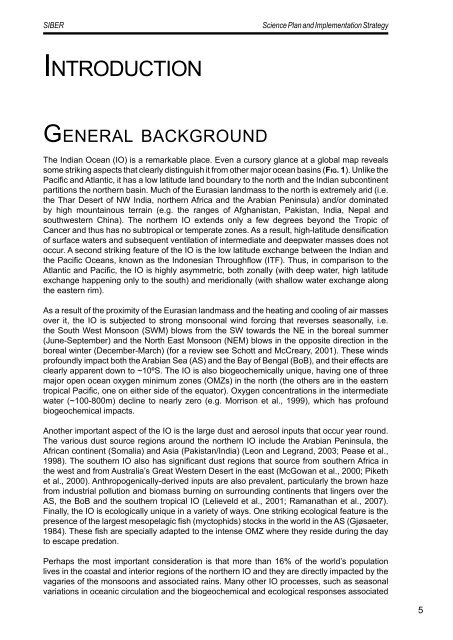SIBER SPIS sept 2011.pdf - IMBER
SIBER SPIS sept 2011.pdf - IMBER
SIBER SPIS sept 2011.pdf - IMBER
You also want an ePaper? Increase the reach of your titles
YUMPU automatically turns print PDFs into web optimized ePapers that Google loves.
<strong>SIBER</strong><br />
Science Plan and Implementation Strategy<br />
In t r o d u c t i o n<br />
Gen e r a l ba c k g r o u n d<br />
The Indian Ocean (IO) is a remarkable place. Even a cursory glance at a global map reveals<br />
some striking aspects that clearly distinguish it from other major ocean basins (Fig. 1). Unlike the<br />
Pacific and Atlantic, it has a low latitude land boundary to the north and the Indian subcontinent<br />
partitions the northern basin. Much of the Eurasian landmass to the north is extremely arid (i.e.<br />
the Thar Desert of NW India, northern Africa and the Arabian Peninsula) and/or dominated<br />
by high mountainous terrain (e.g. the ranges of Afghanistan, Pakistan, India, Nepal and<br />
southwestern China). The northern IO extends only a few degrees beyond the Tropic of<br />
Cancer and thus has no subtropical or temperate zones. As a result, high-latitude densification<br />
of surface waters and subsequent ventilation of intermediate and deepwater masses does not<br />
occur. A second striking feature of the IO is the low latitude exchange between the Indian and<br />
the Pacific Oceans, known as the Indonesian Throughflow (ITF). Thus, in comparison to the<br />
Atlantic and Pacific, the IO is highly asymmetric, both zonally (with deep water, high latitude<br />
exchange happening only to the south) and meridionally (with shallow water exchange along<br />
the eastern rim).<br />
As a result of the proximity of the Eurasian landmass and the heating and cooling of air masses<br />
over it, the IO is subjected to strong monsoonal wind forcing that reverses seasonally, i.e.<br />
the South West Monsoon (SWM) blows from the SW towards the NE in the boreal summer<br />
(June-September) and the North East Monsoon (NEM) blows in the opposite direction in the<br />
boreal winter (December-March) (for a review see Schott and McCreary, 2001). These winds<br />
profoundly impact both the Arabian Sea (AS) and the Bay of Bengal (BoB), and their effects are<br />
clearly apparent down to ~10ºS. The IO is also biogeochemically unique, having one of three<br />
major open ocean oxygen minimum zones (OMZs) in the north (the others are in the eastern<br />
tropical Pacific, one on either side of the equator). Oxygen concentrations in the intermediate<br />
water (~100-800m) decline to nearly zero (e.g. Morrison et al., 1999), which has profound<br />
biogeochemical impacts.<br />
Another important aspect of the IO is the large dust and aerosol inputs that occur year round.<br />
The various dust source regions around the northern IO include the Arabian Peninsula, the<br />
African continent (Somalia) and Asia (Pakistan/India) (Leon and Legrand, 2003; Pease et al.,<br />
1998). The southern IO also has significant dust regions that source from southern Africa in<br />
the west and from Australia’s Great Western Desert in the east (McGowan et al., 2000; Piketh<br />
et al., 2000). Anthropogenically-derived inputs are also prevalent, particularly the brown haze<br />
from industrial pollution and biomass burning on surrounding continents that lingers over the<br />
AS, the BoB and the southern tropical IO (Lelieveld et al., 2001; Ramanathan et al., 2007).<br />
Finally, the IO is ecologically unique in a variety of ways. One striking ecological feature is the<br />
presence of the largest mesopelagic fish (myctophids) stocks in the world in the AS (Gjøsaeter,<br />
1984). These fish are specially adapted to the intense OMZ where they reside during the day<br />
to escape predation.<br />
Perhaps the most important consideration is that more than 16% of the world’s population<br />
lives in the coastal and interior regions of the northern IO and they are directly impacted by the<br />
vagaries of the monsoons and associated rains. Many other IO processes, such as seasonal<br />
variations in oceanic circulation and the biogeochemical and ecological responses associated<br />
5












